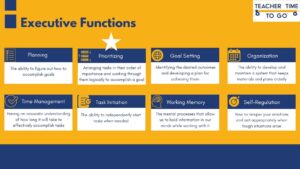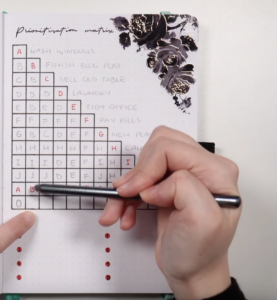Executive Functioning is best understood as the skills we use every day to learn, work and manage daily life. You can think of the term as the skills required to execute tasks.
This is the second post of an 8-part series highlighting Executive Functioning Skills. You will find definitions, parent recommendations, and strategies that can be implemented for immediate support at home for families or in the classroom for teachers. My hope is that by helping you to understand what Executive Functioning is, you’ll be able to best support your child!
This post is all about Prioritizing.
Prioritizing can be understood as arranging tasks in their order of importance and working through them logically to accomplish a goal. Many times, we have a lot of things to accomplish or get done. When we prioritize, we decide which activity is the most important to complete first. It does not mean that the other activity will never be accomplished. It just means that the activity you decide to focus on is more important and needs to be taken care of first.
There are typically four steps to prioritizing that I want to share as our support strategy:
- Write down all of your tasks
- Determine which tasks are truly important
- Tackle the most intense
- Focus on one task at a time
Step 1: Write down all of your tasks
For writing down all of your tasks: LITERALLY, write them down! Whether you want to type it in a note on your phone or handwrite them, get all of those ideas out and recorded somewhere. This will immediately help you feel more organized by putting everything out there. Half of the battle is getting it all written down and out of your head. While doing this, don’t worry about the order of importance, just get everything out there.
My recommendation is not to get too specific, focusing on a thing you want to do each day (for example, workout). That should not be on a to-do list of tasks, but rather included in a daily schedule. We will explore that in more detail below.
Step 2: Determine which tasks are truly important
Now that we have our (long) list, we will determine which tasks are truly important. There are so many ways to do this and I have spent a considerable amount of time identifying the style that works best for me. I like to use the Prioritization Matrix. Here is an awesome video that shows you step by step how to set up the graph and prioritize based on a proven number system that works.
Additionally, you can ask yourself a few questions as you are prioritizing using this matrix. Who does this task impact? What are the consequences if I do not complete the task? What are the benefits if I do complete the task? This will help make the process more efficient.
Step 3: Tackle the most intense
Now that we have our list of tasks in order, we will tackle the highest priority first. This is usually the most intense task. This is often called “eating the frog.” Most of the time, this will be something that needs to get done ASAP in order to get started with the rest of your day, or to avoid consequences later down the road. By attacking the most intense project first thing in the day (and hopefully after a good night’s rest), you’ll most likely be your freshest self and will have the best mental capacity to work through it.
Step 4: Focus on one task at a time
After you are in a good swing of things, it’s important to focus on one task at a time. If you are not structured with this, you will immediately feel overwhelmed and may end up not get anything done. This is the exact opposite of what we are trying to accomplish here! Burnout is real, so make sure that you are taking things one step at a time, literally!
YOU GOT THIS!
Resource for Success
I wanted to share one of my favorite resources for Prioritizing. I recommend this to all families, not just students with Executive Dysfunction, but very commonly as a way to proactively address upcoming issues.

You can use this sequencing activity as a conversation starter, and it can be applied to most situations. While this does not focus specifically on prioritization of tasks, it highlights a specific task and the order in which things need to occur to be effective. There are so many examples on the Teachers Pay Teachers website and the internet that you are able to adapt to what you are looking for.
Final Thoughts
Here at TT2G, we are working with about 500 families in the local community and approximately 75% of those families request some sort of Executive Functioning Support. So, this set of skills is a highly sought-after service.
Next up in the series we will be discussing the skill of Goal Setting!
As a reminder, we will go into detail about each of these with a specific (user friendly definition) and support strategies! This chart below will guide the series!

If you want to review the other posts in the series, you’ll find them here: Executive Functioning Overview, Planning.
Have a prioritizing strategy that works for you? We’d LOVE to hear from you!
Live.Laugh.Learn,
Jenn


